

This effect is known to describe people who observe someone in need of help but do nothing to stop or help the person. Many factors lead to this phenomenon and also ways to counteract it, and we need to understand and know how we can counteract it. What Is the Bystander Effect? If you witnessed an emergency happening right before your eyes, you would certainly take some sort of action to help the person in trouble, right?

While we might all like to believe that this is true, psychologists suggest that whether or not you intervene might depend upon the number of other witnesses present. Bystander Effect: What Is It and What You Can Do About It. What the bystander effect looks like A little after 3 a.m. on March 13, 1964, Catherine “Kitty” Genovese parked her car and walked to her apartment in Queens, New York, after finishing her shift as a bar manager. Serial killer Winston Moseley was out to victimize someone that night. Genovese became his target. When he followed her, she ran.
As Moseley reached her and began stabbing her with a hunting knife, Genovese screamed, “Oh, my God, he stabbed me! When lights in surrounding apartments flipped on and one man called out his window, the attacker ran and hid in the shadows. There was widespread public condemnation of the witnesses who did not come to Kitty Genovese’s aid. The related terms “bystander effect” and “diffusion of responsibility” were coined by social psychologists as a result of this research. The bystander effect describes situations in which a group of bystanders witness harm being done, yet do nothing to help or stop the harmful activity. According to the U.S. How Kitty Genovese's Brutal Murder Created the "Bystander Effect" When 28-year-old Catherine Susan Genovese was killed outside her apartment in Kew Gardens, Queens, 38 people reportedly witnessed the attack but didn’t get involved.

Known to her friends as Kitty, she had only lived at 82-70 Austin Street for a year with her girlfriend, Mary Ann Zielonko, before returning on the night of March 13 from her job managing a bar. Two weeks later, the assault and murder of this charming and bright-eyed woman became headline news. In his book, Kitty Genovese: The Murder, the Bystanders, the Crime That Changed America, journalist Kevin Cook reports that the 38 figure, which would later prove to be incredibly influential, is inaccurate. “Thirty-eight” was tossed out by New York City Police Commissioner Michael Murphy while at lunch with the city editor of the New York Times, A.M. Rosenthal. Genovese’s murder shaped the social dynamic of cities and how Americans are taught to perceive their place as one person within a multitude.
Here’s what actually happened: Bystander effect. Bystander effect, the inhibiting influence of the presence of others on a person’s willingness to help someone in need.
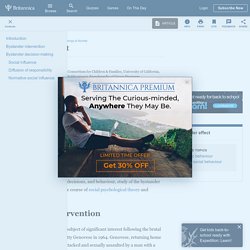
Research has shown that, even in an emergency, a bystander is less likely to extend help when he or she is in the real or imagined presence of others than when he or she is alone. Moreover, the number of others is important, such that more bystanders leads to less assistance, although the impact of each additional bystander has a diminishing impact on helping.
Investigations of the bystander effect in the 1960s and ’70s sparked a wealth of research on helping behaviour, which has expanded beyond emergency situations to include everyday forms of helping. By illuminating the power of situations to affect individuals’ perceptions, decisions, and behaviour, study of the bystander effect continues to influence the course of social psychological theory and research. How to Break the Bystander Effect. They could have left it to someone else. An Army veteran blocked a shooter in Oregon from entering his classroom. Three friends on a high-speed train from Paris to Amsterdam helped stop a gunman wielding an AK-47. This past spring, an Army captain in North Carolina pulled a couple to safety after a fiery car crash. Were these men instinctively courageous, or had they learned to be?
The Army captain (aptly wearing a Captain America T-shirt) credited his military training for knowing what to do and remaining calm. These heroes are dramatic examples. And this conundrum is not limited to thwarting terrorism or physically saving someone. Summary. Diffusion of Responsibility: Definition and Examples in Psychology. What causes people to intervene and help others?
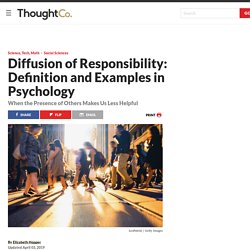
How Diffusion of Responsibility Affects Group Behavior. Diffusion of responsibility is a psychological phenomenon in which people are less likely to take action when in the presence of a large group of people.1 For example, imagine that you are in a large city on a bustling street.

You notice a man fall to the ground and start convulsing as if having a seizure. Many people turn and look at the man, but no one moves to help or call for medical assistance. Why? Because there are so many people present, no one person feels pressured to respond. Summary. How to Overcome the Bystander Effect. Psychologists have long been interested in exactly why and when we help other people.
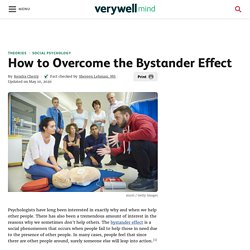
There has also been a tremendous amount of interest in the reasons why we sometimes don't help others. Bystander Effect Demonstrates That People Help Each Other. The antidote to the bystander effect lies in one of the many questions we ask ourselves: Are other people in the group aware of me?
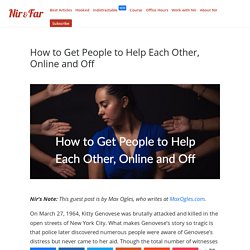
Most of the time, we see ourselves as invisible members of the group; we’re part of the collective but not singled out. When we begin to feel that the group is aware of us personally, then we decide to take action. For example, if I knew that a TV camera would air video footage of me driving past the vehicle in distress, I would be much more likely to stop and help.
Psychologists call this “public self-awareness” and it’s the key to reversing the bystander effect. Reducing the Bystander Effect. As discussed, there are a number of factors that magnify the Bystander Effect.
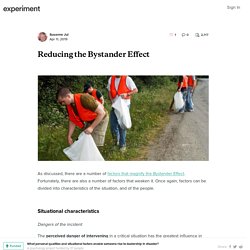
Fortunately, there are also a number of factors that weaken it. Once again, factors can be divided into characteristics of the situation, and of the people. Situational characteristics. Summary. Conclusion.